SERVICES
We provide
services
for your oral health care.


Laser treatment is a new treatment technology in dentistry.
The devise is a diode laser that can provide fast and blooodless surgical capabilities, numerous cleaning processes and pain treatments as well as whitening treatments.
Laser
Whitening:
It is painless method whitening which has great aesthetic results (colouring). The use of the whitening gel in combination with the laser in just one 20-30 minute appointment can make your smile brighter.
Pain treatment:
The use of this laser has excellent results in treating the pain in temporomandibular joints and face muscles pain that look similar to myalgia. A few applications with the specific attachment that this laser machine has, will give an instant pain relief feeling to the patient.
Soft tissues:
In addition this laser can be used in the classic periodontics treatment. As a supplementary mean for these treatments it can contribute to the cleaning and curettage of gingival sulcus. It can also contribute to the healing of the inflammations from dental implants (peri-implantits). The caps from impacted or semi-impacted teeth can be removed and the surgical crown lengthening can also be treated by this laser painless and effortless.
Its results are particularly successful in the excision and removal of hypertrophic frenum (in children and adults) as well as in plastic surgery of the gums. It also offers faster healing and a more painless course in both patients with aphthae and herpes labialis patients. It offers very good results and painless treatment in cases of hemostasis, abscess rupture, in patients undergoing pulpotomy, as well as in endodontics (root canal treatment) for root canal disinfection.
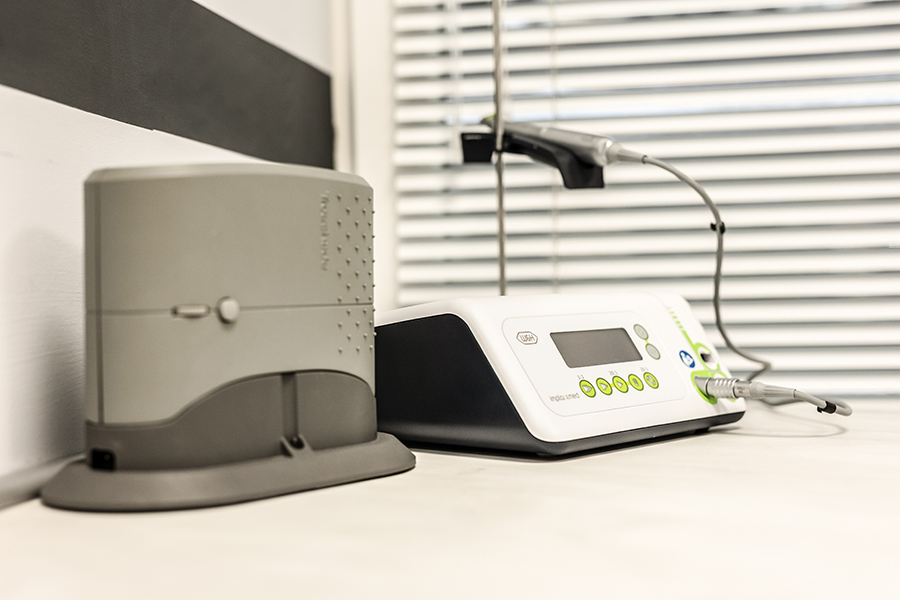
In our clinic, oral surgery services are performed by qualified and experienced dental surgeons.
Oral surgery
Teeth and root surgical removal:
The surgical tooth and root removal is an everyday dental task for a dentist. When a tooth is fractured, but the roots are still inside jaw bone, the surgical removal is needed. In addition, it is necessary to intervene surgically when during the extraction of a tooth it breaks at the level of the root due to its particular morphology and bending.
Wisdom teeth surgical removal:
Wisdom teeth or third molars, are usually the last teeth that erupt in the oral cavity. There are cases in which these teeth will not erupt completely (semi impacted ) or they will stay inside the jaw bones (impacted). These conditions could create issues and thus the surgical removal is advised.
The symptoms that lead to the surgical removal of these teeth are: pain due to inflammation (pericoronitis), created by the gum (cap) around the tooth, caries (dental decay) and periodontal problems that could appear to the adjacent teeth because the patient can not keep that area clean and lastly the slope that these wisdom teeth have can created pressure to the adjacent teeth, forcing them to move and crook.
Oral plastic surgery:
This includes treatments that aim to restore the soft tissues and bones in the mouth cavity. The surgical treatment of the soft tissue can be used for:
Surgical crown lengthening, in order to reveal a greater part of the tooth in height or in width by removing the corresponding gum segment. Another surgical procedure that aims to remodel the gums is called gingivoplasty / ulectomy, which can contribute to either the aesthetics of the mouth cavity or used for treating. The most common use of the aforementioned treatment is performed on patients with gummy smile or with gingivitis hyperplasia.
Another use of this surgery is for the frenectomy, where the soft tissues that connects the gums with the lips is removed, when it creates issues with the functionality of the oral cavity (oral hygiene, speech etc). Finally gingival recession, the condition where the gums recede leaving exposed roots, a surgical treatment is necessary to restore them and if needed (see oral surgery, dental implants - bone grafts) can be used either from the patient or artificial graft. The cases where we intervene surgically in order to preserve and reshape the bone include the procedure of apicectomy (see endodontics, apicectomy), the bisection or excision of the root from a multi-root tooth (molar) along with the corresponding crown segment. It is a technique that is applied to one of the roots of the teeth when it shows caries, periodontal damage and absorption. By bisecting and then removing the infected root, the tooth and most importantly the alveolar bone surrounding it is preserved.
Finally, in cases where multiple tooth extractions are performed, it is possible that during healing, sharp bone surfaces may appear under the gums. In order to avoid this situation, a plastic surgery should be performed in order to smooth the alveolar process.
Dental Implants - Bone implants:
Dental implants is the most advanced method to encounter the voids in the oral cavity due to the loss of one or more teeth. These are screw made from biocompatible materials (titanium), which after the clinical and radiographic examination, are surgically installed in the jaw bone creating the base on which the dentist will continue with the prosthetic restoration of the teeth (dental crown - bridge). These implant will have to go through the osseointegration stage. The basic requirement for installing these implants is the jaw bone must have enough width and height. There are cases which there is not enough space on the bone either on the upper or lower jaw.
In the maxilla, the main ‘obstacle’ is the sinus, which creates difficulties in installing the implants due to the lack of height. In these cases, when possible, surgical elevation of the sinus floor is performed to create space along with bone graft placement and then implants are placed. The same issue can be found in the mandible due to bone resorption. In this case bone graft has to be installed in order to create the base for the dental implants as in the previous situation.
The cases of bone loss (due to periodontitis or tooth removal) bone grafts are used (either animal based-artificial or autologous grafts) in combination with guided bone regeneration, which is a biocompatible membrane, in order to restore the bone structure. The most advanced method of creating autologous grafts and membranes is the PRF (Platelet Rich Fibrin). In this technic we sample blood from the patient which is then centrifuged using special equipment separating the ingredients and the doctor used the plasma and the platelet growth factors in order to created the bone graft (sticky bone) and membrane. These ingredients can be used in numerous surgical treatments with safety, since all of them are obtained from the patient, such as for the regeneration of the bone and gingival regeneration after a tooth removal and for creating bone grafts for the dental implant installation.
Surgical cyst and small benign tumor removal:
In cases where the patient has a benign tumor or cyst, for example fibroma, lipoma and thelioma, then it is advised a surgical resection. In some cases and if the doctor thinks it is necessary, the sample will be send for biopsy.
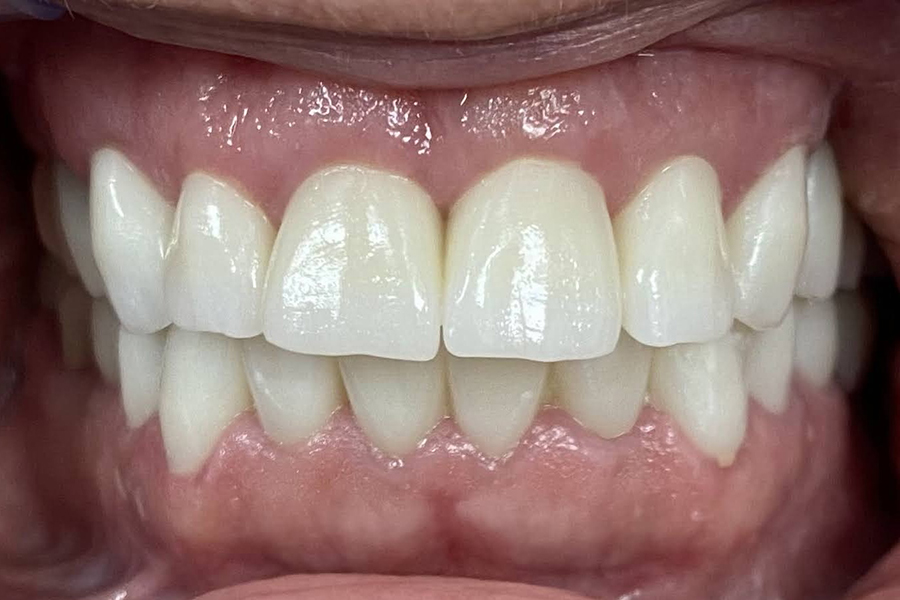
In our clinic, dental prosthetic services are provided by qualified and experienced dental surgeons.
Prosthodontics
Dental crown:
A crown is a permanent, full-coverage prosthetic restoration that simulates the color, shape and size of natural teeth. A crown is placed either on a tooth that is weakened due to a large loss of tooth substance or on an endodontically treated tooth to protect and strengthen it. In addition, when placed on more teeth it can improve the aesthetics of your smile.
Based on the material of construction, there is a metal-porcelain crown that is placed mainly on the posterior teeth, as well as a zirconia-crown (case) suitable for both anterior and posterior teeth. Zirconia is the new "white gold" with excellent aesthetic and
mechanical properties.
Dental bridge:
A bridge is a permanent, full-coverage prosthetic restoration that simulates the color, shape and size of natural teeth. It is placed on two or more teeth, between which a void has been created due to the loss of one or more teeth. By covering this empty space, the bridge improves chewing, which is affected when teeth are missing, protects the adjacent teeth and the antagonists of the missing teeth, and improves the patient's aesthetics and speech when teeth are missing from the anterior region.
As in the case of the crown, the material of construction of the bridge can be metal-porcelain or zirconia.
Dental posts:
When an endodontically treated tooth has a large loss of tooth substance it is not able to support a filling and / or a crown. For this reason, a dental post is placed at the root to hold the permanent restoration (filling or crown).
There are two types of dental posts: Customized metal cast posts welded to the root of the tooth and prefabricated fibre glass, zirconia or metal posts that are welded or screwed.
Veneers:
This is a minimally invasive aesthetic procedure in which a small amount of tooth substance is removed from the front surface of the teeth. The tooth substance is then replaced by "thin shells" of zirconia that are bonded to the tooth surface. One of the benefits of zirconia veneers is their resistance to fracture compared to resin veneers and, in addition, the colour of these veneers does not change over time or due to the patient's eating habits.
Ζirconia veneers are indicated in cases where it is necessary to change the shape of the teeth, to close spaces between the teeth (e.g. in teeth spacing), when the teeth have various fillings resulting in discoloration and finally when the patient wants a completely natural and aesthetic white smile.
Maryland bridge:
The Maryland bridge is a minimally invasive prosthetic restoration for those cases where there is a loss of an anterior tooth. It consists of the frame (metal or zirconia) with a tooth on the anterior side, which replaces the missing tooth. In addition, there are two "wings", which fit on the inner surface of the adjacent teeth, which are minimally reamed. It is usually used when there is a congenital missing tooth in children or as a temporary solution until an implant is placed in the patient.
Prosthetics on implants (crown or bridge):
After placement and osseointegration of one or more implants, prosthetic restoration follows. This may be a single crown on the implant, a bridge on at least two implants or a removable restoration (full complete denture) on several implants. Implant restorations are made of i) metal-porcelain ii) zirconia iii) all-ceramic material and can be placed either by bonding or by screwing as well as by a combination of the two.
Removable prosthetic restorations:
Full complete dentures:
When the patient has lost all his teeth or even if he has some which have a poor prognosis and need to be extracted, then to restore chewing function, speech and also facial aesthetics, full dentures are placed. These are artificial prosthetic restorations made of pink acrylic resin and artificial acrylic teeth in the appropriate colour and shape.
Partial dentures:
Like full dentures, partial dentures are mobile prosthetic restorations that are placed and removed daily by the patient. With these restorations some teeth are retained in the mouth, which act as their supports. They are also made of a pink acrylic base, a frame, the artificial teeth and the clasps that are attached to the natural teeth supports.
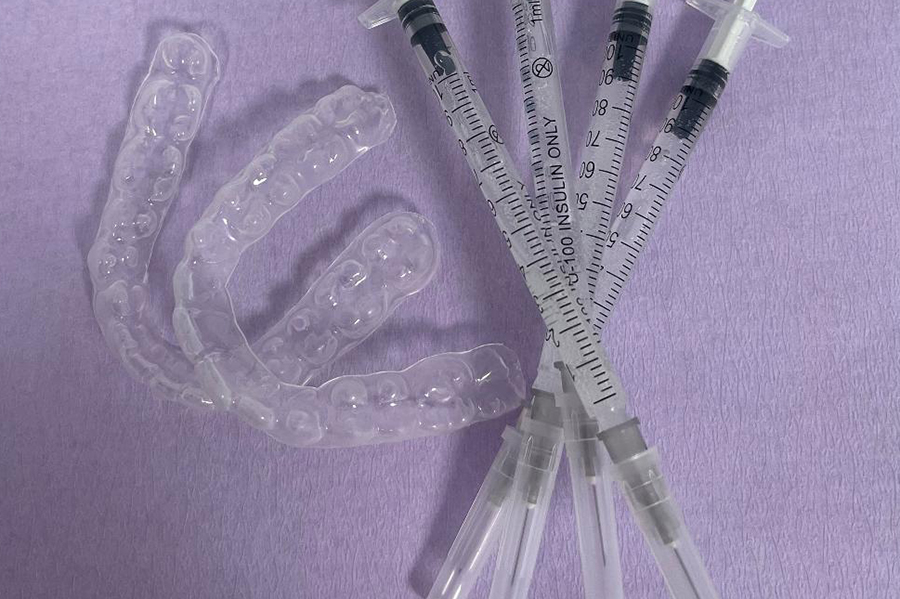
In our clinic, cosmetic dentistry services are provided by qualified and experienced staff.
Aesthetic dentistry
Whitening:
Over time, our teeth lose their natural whiteness and brightness. This happens, either because of wear and tear of the enamel of the teeth, or because of the dyes deposited on the dental surfaces by the daily use of food and beverages (e.g. coffee), tobacco and medicines. The simplest procedure to get a beautiful and bright smile again is whitening. It is a safe, quick and effective procedure for changing the color of teeth. Ways to perform whitening:
In-office whitening using Laser.
In-office whitening using a special LED lamp.
Whitening at home with special personalized splints.
Fillings:
Fillings are a restorative procedure for any cavities (holes) and "micro-fractures" that occur in the teeth mainly due to caries. They repair the teeth and prevent the damage from extending to the pulp of the tooth.
The material used to fill the cavities is composite resin. These are "white fillings", which have a very good functional and aesthetic performance.
Composite Veneers (Bonding):
Composite Veneers are a simple, quick and non-invasive method of aesthetic dentistry, which is designed to improve small "imperfections" in the patient's smile. They are performed with resinous material (high quality white filling) as "thin shells" that are bonded to the front surface of the teeth. It is a procedure, which is usually completed in one appointment. Resin veneers are indicated when desired:
To straighten to a small degree any crooked teeth.
To improve the shape, size and colour of the teeth.
To cover minor discoloration of the teeth.
To restore cracks and broken corners of teeth.
To give a uniform appearance to teeth when they have multiple fillings.
To reduce or completely close the void in cases of sparse teeth (teeth spacing).
To modify the shape of individual teeth (in cases of "congenital missing") so that they resemble the missing teeth.
Tooth jewellery (Strass):
Dental-Strass is a cosmetic type of accessory, which is part of the field of aesthetic dentistry. It is a "jewel", which is placed on the front surface of the teeth (usually in the Incisors of the upper jaw) easily and painlessly without "grinding" the dental surface.
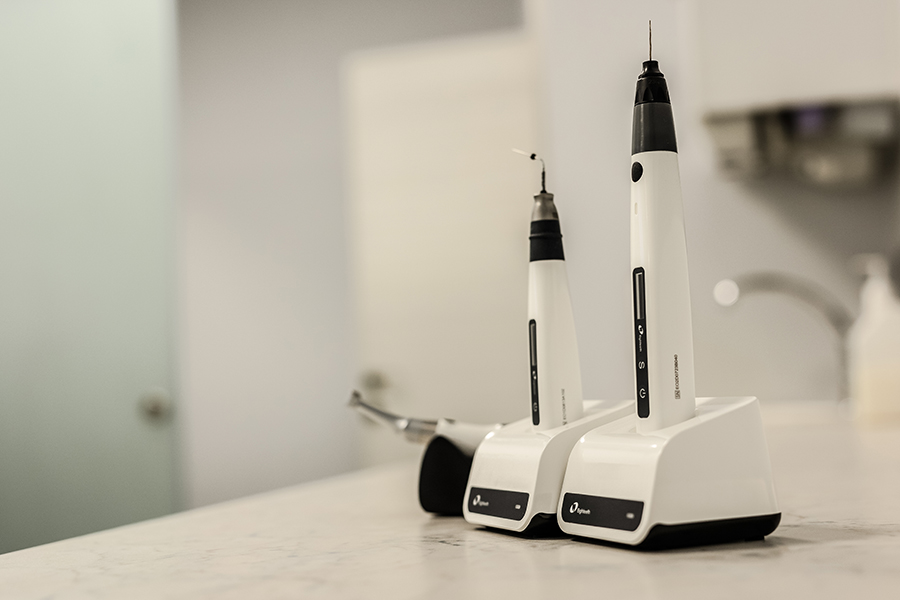
In our clinic, we perform endodontic dental treatments by qualified and experienced dental surgeons.
Endodontics
Endodontic treatment (root canal treatment):
It is a dental work, which is performed inside the tooth with the aim of keeping it inside the oral cavity and avoiding its extraction. Specifically, when the pulp of the tooth becomes infected or inflamed due to deep decay, fracture or crack as well as from pre-existing extensive dental restorations, patients experience some symptoms. These symptoms are pain when chewing, sensitivity to hot or cold, swelling in the area and also severe pain when lying down at night. There is also the possibility that a tooth may not hurt or appear to be damaged and may have a dead pulp (nerve). Based on the above, the dentist decides on endodontic treatment, during which the "infected nerve" is removed from the tooth using special rotary instruments, thoroughly cleaned and followed by hermetic sealing.
Endodontic retreatment:
There are cases of teeth, which often due to their particular anatomy, the inability to access and clean up to the apex, a broken filling or even due to the recurrence of caries, do not respond positively to the initial endodontic treatment. Thus, after a period of months or even years, they experience pain and perhaps even swelling again. Therefore, the endodontic retreatment is carried out to give these cases another "chance".
The dentist removes the existing filling material and any restoration (filling or crown) from the tooth and repeats the thorough cleaning and new filling of the tooth.
Apicectomy:
When none of the above methods work and the tooth is reinfected then the last step before extraction is surgical removal of the tooth's apex. The dentist creates an incision in the apical area, from where he removes the infected tissues as well as 3 mm of the apical area and places the reverse filling there. Stitches are placed at the incision site and healing of the area follows.
Treatment of dental trauma:
After an accident or a blow (e.g. in a sporting activity) some teeth may become impacted (displaced) or fully impacted (removed from the mouth). In these cases they should be repositioned in their original position, immobilized and checked to see if the pulp tissue remains normal. In cases where it is not affected, endodontic treatment is not necessary. On the contrary, if the pulp is necrotic then endodontic treatment is recommended in order to preserve the tooth in the oral cavity.
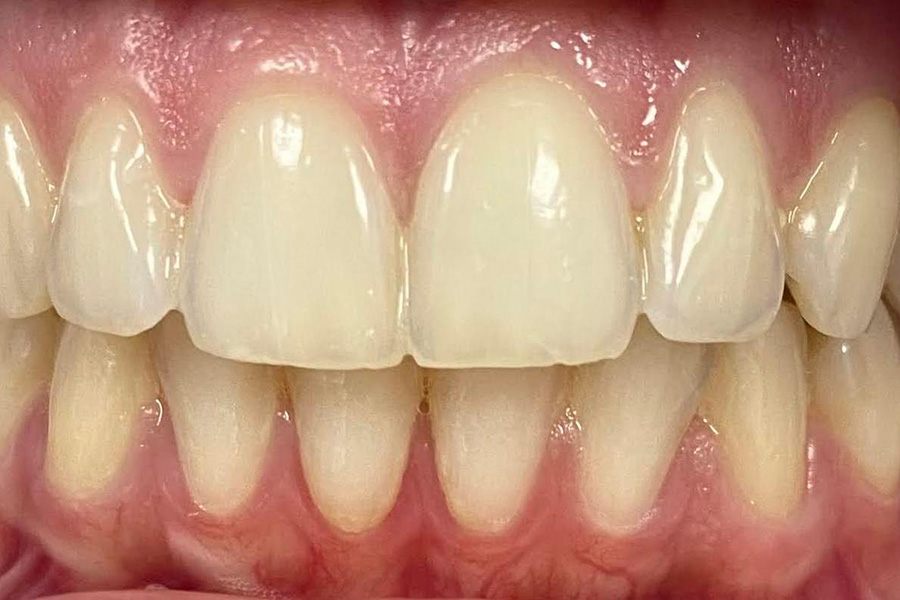
In our clinic, periodontal dental treatments are carried out by qualified and experienced staff.
Periodontics
Cleaning – scaling:
Cleaning or scaling is the treatment in which calculus is removed form the surfaces of the teeth using ultrasound. The following step is the polishing of the teeth with fluoride paste and the sodium air polishing in order to remove coloured stains from the visible surfaces. It is advised to patients to repeat this treatment every 6 months in combination with the dental check up.
Gingivitis:
It is an inflammation of gums which is caused by the accumulated plaque. The patient with gingivitis will have bleeding gums, ruddiness, gum swelling and halitosis. This condition can be confronted by regular dental cleaning and training in maintaining a proper mouth hygiene. If this condition is not treated correctly it could lead to periodontitis.
Many predetermined factors can contribute to the appearance of these conditions and its severity. One of these is pregnancy which the hormone disorders can create gum bleeding and inflammations. The correct oral hygiene and regular cleaning treatments can protect the gums during pregnancy.
Periodontitis:
This condition is an inflammatory mouth disease, which does not only effect the gums as the gingivitis but also the bone that holds the teeth. The gems that are present in the accumulated plaque, infect and destroy the bone, which subsides creating voids named “periodontal pockets”. In these pockets more gems are gathering a further damage is created to the bone which result to teeth falling. In addition to the symptoms of gingivitis, it also shows gingival recession, pus discharge from the gums, tooth mobility and radiographic bone loss.
According to research data, periodontal disease is associated with heredity, but also with the occurrence of pathological conditions such as diabetes mellitus, osteoporosis and cardiovascular diseases.
The treatment of periodontitis is followed by the removal of the supragingival and submucosal tartar with ultrasound, hand instruments and laser (conservative phase) and if necessary additional surgical treatment.
A prerequisite for the success of the treatment is the patient's compliance with very good oral hygiene.
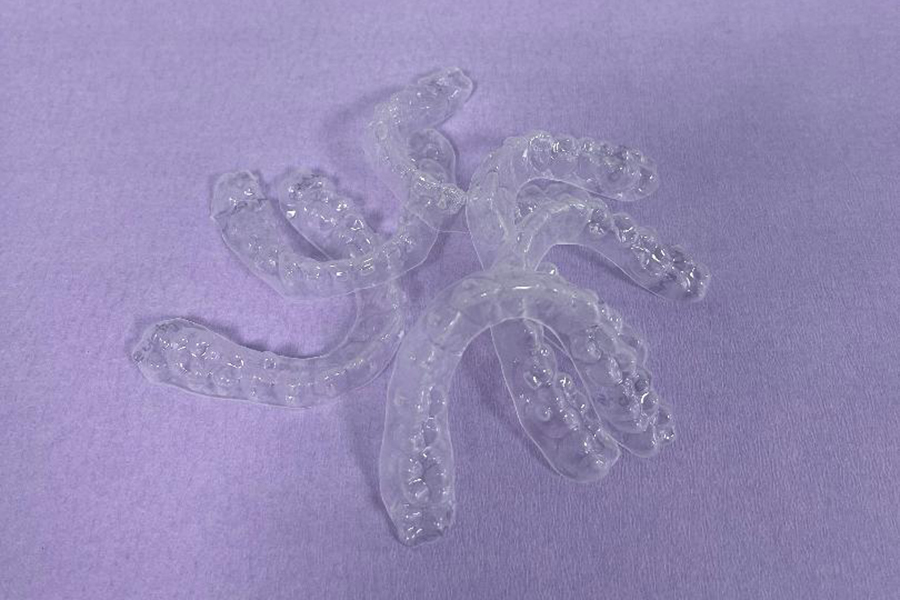
In our clinic, orthodontic dental treatments are carried out in collaboration with a specialized orthodontist.
Orthodontics
Transparent splints / Invisible orthodontics:
Invisible orthodontics is the most modern method for treating orthodontic problems. This method consists of customized transparent splints for each patient that are replaced in succession. It is a "friendly" method especially for adults because of its good aesthetic performance.
Metal braces:
Metal braces is the most classic method to confront the orthodontic problems, in which special brackets are glued on the visible surface of the teeth which are connected with special orthodontic wire and rubber bands. This approach is popular and preferred for children and teenagers and it is necessary to introduce and maintain a good oral hygiene.
Ceramic braces:
Ceramic braces are placed and function the same way as the metal ones, but due to the transparent material that they are made off, they are less apparent. Just like in the metal braces therapy, a good oral hygiene has to be adhered. This method is commonly used for teenagers and adults.
Lingual braces:
The lingual braces operate with the same principal as the metal and ceramic braces, with the only difference been the positioning of the brackets on the inside surface of the teeth (lingual). This method has excellent results and the patient need to maintain a good oral hygiene. This therapy is popular amongst adults and teenagers.
Orthodontic retention or with a stabilisation splint:
After the completion of orthodontic treatment, it is necessary to place orthodontic retention so that orthodontic movements can be maintained in the long term.
Retainer:
This is an orthodontic wire that is permanently placed on the inner surface of the teeth of the upper and lower jaw.
A splint for retaining the orthodontic result:
It is an alternative solution for stabilizing the orthodontic result. It is a transparent splint. The patient wears it in the evening, perhaps for some hours during the day, which the orthodontist determines according to the severity of each case.
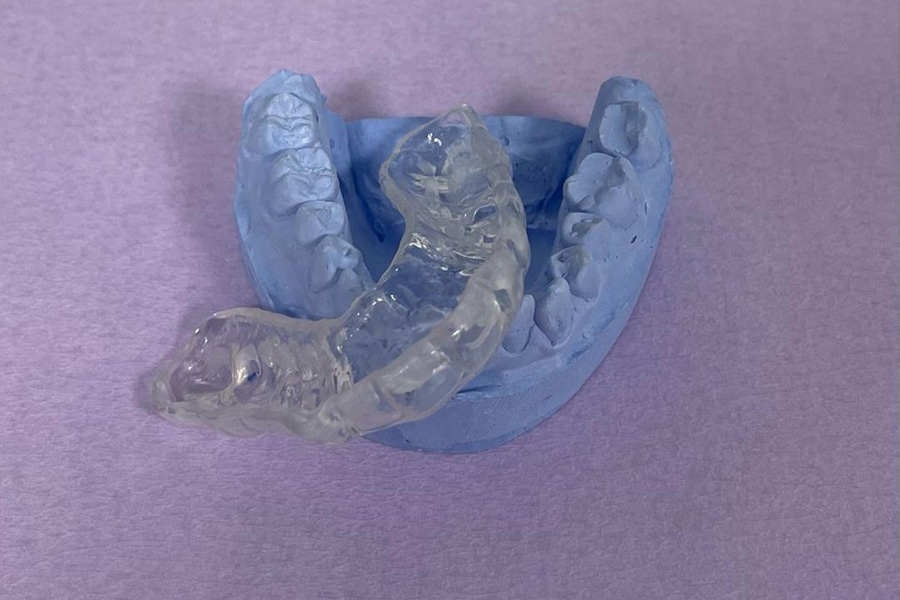
In our clinic, a service for intraoral braces is carried out in collaboration with a specialized orthodontist.
Intraoral mouth guards
Sport mouth guard:
It is a personalized elastic made mouth guard and its purpose is to protect the athletes in sports with contact from possible dental trauma. It can be made in different colours and additional imprint can be added such as the team's logo or the athlete's name.
Bruxism mouth guard:
It is a personalized transparent and relatively rigid mouth guard, which is used mainly on the upper jaw in order to protect the patient from grinding and clenching the teeth during sleep. Furthermore, it is used on patients with extensive prosthetics (dental bridge and crowns) to protect against fractures.
Apnea - Sleeping mouth guards:
This is a personalized mouth guard, one for the upper and one for the lower jaw connected together by a mechanism. Its purpose is to facilitate the passage of air from the upper airways to the lungs during sleep without the use of a nasal mask. It is a perfectly safe treatment against snoring and sleep apnea.
Surgical implant splint:
This is a personalized splint on which there are some holes, which are made with the help of specialized software according to the positions where the implants will be placed (guided implant placement).
It is a guide for the surgeon to facilitate the placement of implants, reducing the operation time, post-operative pain and healing time for the patient, since the implants are placed without the need to create a flap with a scalpel.
Retaining splint:
(See orthodontic, A splint for retaining the orthodontic result).
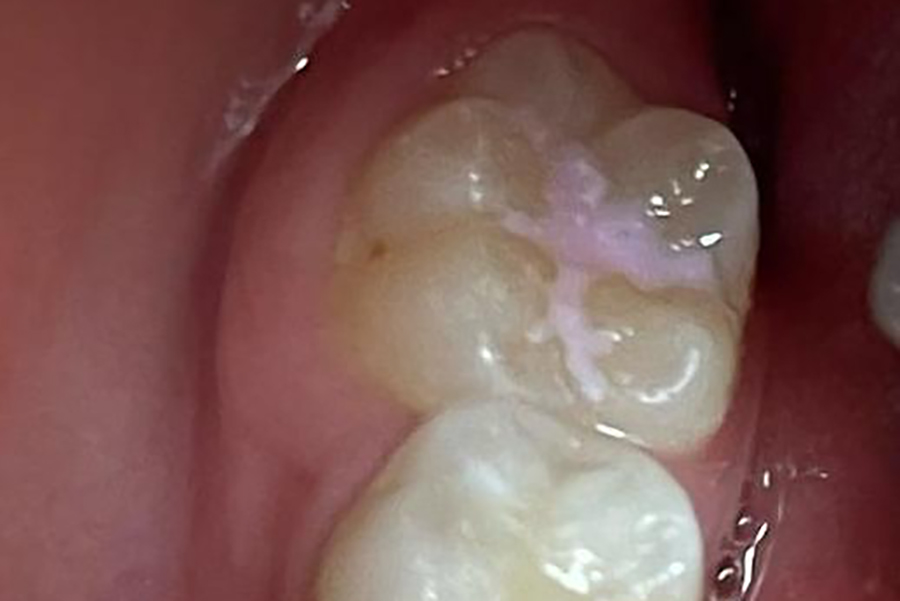
In our clinic, pediatric dental treatments are carried out by qualified and experienced staff.
Pediatric dentistry
Teeth cleaning and fluoridation:
Tooth cleaning is a painless procedure for young patients, which aims to remove microbial plaque from dental surfaces. After this procedure, fluoridation, which is a topical application of a fluoride gel on the surface of the teeth, should also be carried out in order to make the teeth more resistant to the appearance of decay. The first fluoridation should be done around the age of 3 years when the primary teeth have risen and should be repeated approximately every year.
Preventive fillings (holes and fissures):
Permanent molars have some bores (holes) and some grooves (fissures) in which food debris and microbes get trapped, resulting in caries. To prevent this situation, preventive fillings (sealants) are available. They are a simple, painless and safe method to prevent caries without grinding the tooth. The procedure involves cleaning the tooth with a brush and placing liquid resin in the holes and fissures of the tooth. Preventive fillings begin at the age of 6 years, when the first permanent molars emerge, and 12 - 13 years, when the second permanent molars emerge.
Treatment of caries with fillings:
Both deciduous and permanent teeth are affected by dental caries, which creates cavities (holes) on the surface of the teeth, destroying the enamel. These cavities are very small to large and are brown or black in colour. Thus, the dentist's goal is to remove the caries with special instruments, clean the tooth and place the filling material.
Pulpotomy - Endodontic treatment (children's root canal treatment):
Due to its rapid progression in the deciduous teeth, dental caries can affect the pulp (nerve) of the tooth. Usually young patients experience pain and / or swelling. Usually young patients experience pain and / or swelling. With a pulpotomy, the dentist cleans the infected pulp and removes the caries and then places a special antimicrobial medication to achieve antisepsis and sealing. This procedure is performed after anesthetizing the small patient.
Pediatric root canal therapy is performed on children's permanent teeth, when the caries has reached the pulp and there is a manifestation of pain, which does not subside. During the root canal procedure, the dentist removes all the pulp from the roots of the tooth, followed by its filling with a special material.
Young patients with very extensive caries lesions or severe trauma to the front teeth usually undergo this treatment.
Restoration of damaged deciduous teeth with crowns:
When caries has severely damaged the deciduous tooth and the filling is not sufficient to protect it from chewing forces, the dentist should cover the tooth with a crown. This covers the entire tooth and protects it from decaying or even fracturing again. In addition, the crown can also be placed on a tooth that has had a pulpotomy for greater protection.
Treatment of disorders of tooth formation and bad habits:
Both deciduous and permanent teeth can develop disorders involving their number, shape and size. In these cases, the dentist should examine the young patient, diagnose the disorder in question and proceed with treatment.
These disorders are:
Supernumerary teeth,
Congenitally missing tooth,
Teeth Spacing / Oversized teeth,
Hypercalcification,
Incomplete amelogenesis and dentinogenesis.
Bad habits in small patients are particularly common. In particular, we mention the habit of many children to suck their finger or pacifier, bite their nails or other hard objects.
The persistence of bad habits will lead in the future to various orthodontic, aesthetic and functional problems. So the aim is to diagnose them from preschool age and with the cooperation of the dentist and parents to reduce and slowly eliminate them.
Treatment of dental trauma:
Dental trauma is an unpleasant but common condition, especially during childhood and adolescence. It is caused by sports activities, falls and accidents. Depending on the type of trauma and the severity of the damage, the treatment of the tooth will be determined. The majority of dental injuries are cracks and small fractures of the tooth crown, less often a tooth moves and rarely comes out of the mouth. Dental trauma must be evaluated immediately by a dentist in order to preserve the tooth in the oral cavity.
Extraction of a deciduous tooth:
When a deciduous tooth is very damaged and cannot be restored either with a filling or a crown, the only solution is extraction. Many times these teeth show pus therefore extraction is recommended for the good general health of the young patient.
In addition, when a permanent tooth has emerged but the baby tooth has not yet fallen out, then the extraction of the deciduous tooth should be performed in order for the permanent tooth to find its proper position in the dental barrier.
CONTACT US
Our high training is seen in the even result of our services.
